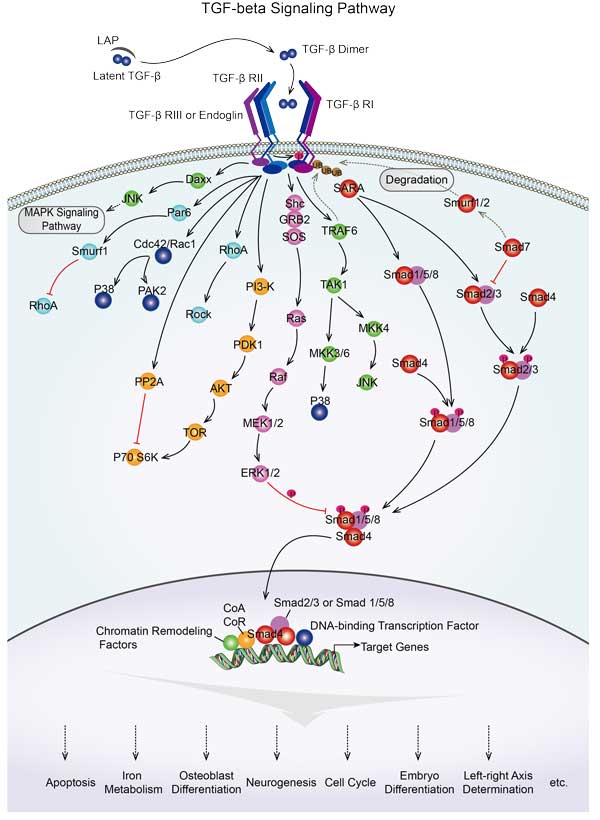TGFBR1
-
Official Full Name
transforming growth factor, beta receptor 1
-
Overview
The protein encoded by this gene forms a heteromeric complex with type II TGF-beta receptors when bound to TGF-beta,;transducing the TGF-beta signal from the cell surface to the cytoplasm. The encoded protein is a serine/threonine;protein kinase. Mutations in this gene have been associated with Loeys-Dietz aortic aneurysm syndrome (LDAS). Multiple;transcript variants encoding different isoforms have been found for this gene. -
Synonyms
TGFBR1; transforming growth factor, beta receptor 1; transforming growth factor, beta receptor I (activin A receptor type II like kinase, 53kD); TGF-beta receptor type-1; activin A receptor type II like kinase; 53kDa; ACVRLK4; ALK 5; tbetaR-I; TGF-beta re;
- Recombinant Proteins
- Cell & Tissue Lysates
- Bos taurus (Bovine)
- Chicken
- Homo sapiens (Human)
- Human
- Human
- Mouse
- E.coli
- E.coli expression system
- HEK293
- HEK293T
- Human Cell
- Insect Cell
- Insect Cells
- Mammalian Cell
- Sf21
- Sf21 Insect Cell
- Sf9 Insect Cell
- C
- hIgG
- His
- Fc
- Fc Chimera
- Flag
- GST
- hFc
- Avi
- mFc
- Myc
- DDK
- Myc|DDK
- N/A
- N
- No tag
- Background
- Quality Guarantee
- Case Study
- Involved Pathway
- Protein Function
- Interacting Protein
- TGFBR1 Related Gene Family
- TGFBR1 Related Research Area
- TGFBR1 Related Signal Pathway
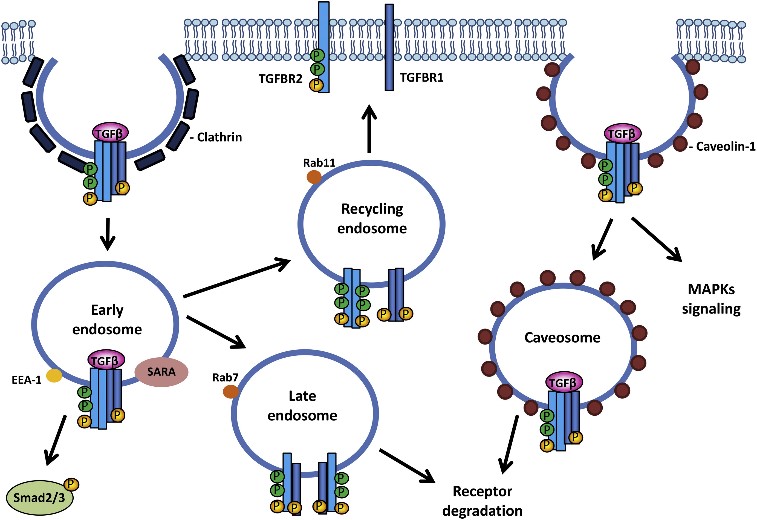
Fig1. Membrane trafficking of TGFBRs. TGFBRs on the plasma membrane are rapidly turned over through clathrin- or caveolin-mediated endocytosis. (Alexandra Vander Ark, 2018)
What is TGFBR1 protein?
TGFBR1 (transforming growth factor beta receptor 1) gene is a protein coding gene which situated on the long arm of chromosome 9 at locus 9q22. TGFβR1 or transforming growth factor, beta-receptor 1 is a member of the TGFβ receptor subfamily and is a ser/thr protein kinase that forms a heteromeric complex with type II TGF-beta receptors when bound to TGF-beta, transducing the TGF-beta signal from the cell surface to the cytoplasm. The TGFBR1 protein is consisted of 503 amino acids and its molecular mass is approximately 56.0 kDa.
What is the function of TGFBR1 protein?
TGFBR1 is a membrane bound serine/threonine kinase receptor. Its main function is to act as a receptor for transforming members of the growth factor-β (TGF-β) superfamily, mediating the transfer of TGF-β signals from the extracellular to the intracellular. TGF-β signaling pathway plays a key role in regulating cell proliferation, differentiation, migration, apoptosis and extracellular matrix synthesis. Normal function of TGFBR1 is essential for maintaining tissue homeostasis.
TGFBR1 Related Signaling Pathway
The TGF-β signaling pathway is the most important signaling pathway. In this pathway, TGF-β ligands first bind to TGF-β type II receptors, leading to phosphorylation of type I receptors such as TGFBR1. Phosphorylated type I receptors in turn activate SMAD proteins, which enter the nucleus and regulate gene expression. This pathway interacts with many other signaling pathways (cross-talk). For example, it interacts with pathways such as WNT, Hippo, Notch, IFN, TNF, and RAS, and this interaction can affect a variety of biological processes such as cell proliferation, differentiation, and apoptosis.
TGFBR1 Related Diseases
Normal function of TGFBR1 is essential for maintaining tissue homeostasis and inhibiting tumorigenesis, but its dysfunction has been associated with a variety of diseases, including cancer, pulmonary fibrosis, and certain genetic disorders such as Loeys-Dietz syndrome and hereditary hemorrhagic telangiectasia (HHT). In addition, there are atherosclerosis, liver cirrhosis, diabetic nephropathy and so on.
Bioapplications of TGFBR1
As a potential drug target, TGFBR1 research may drive the development of new therapeutic strategies. For example, research targeting dual inhibitors of TGF-β/PD-L1 may provide new avenues for tumor treatment.
High Purity
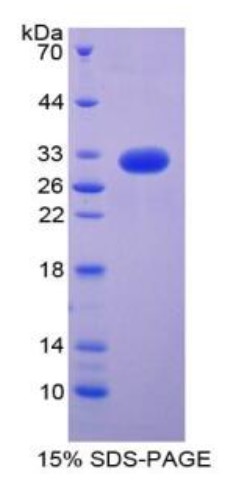
Fig1. SDS-PAGE (TGFBR1-589H) (PROTOCOL for western blot)
.
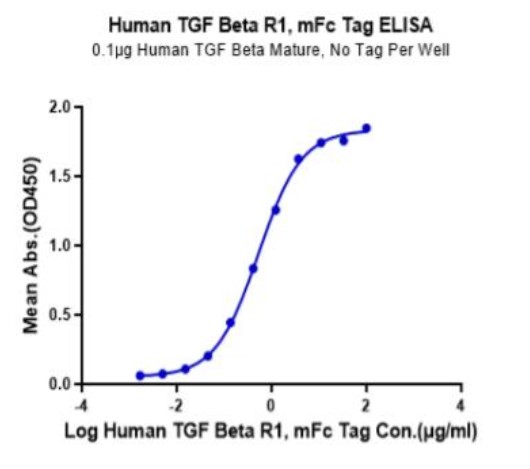
Fig2. Activity Data. (TGFBR1-698H)
Case study 1: David A Monteiro, 2021
Bone is a dynamic tissue that constantly adapts to changing mechanical demands. The transforming growth factor beta (TGFβ) signaling pathway plays several important roles in maintaining skeletal homeostasis by both coupling the bone-forming and bone-resorbing activities of osteoblasts and osteoclasts and by playing a causal role in the anabolic response of bone to applied loads. However, the extent to which the TGFβ signaling pathway in osteocytes is directly regulated by fluid shear stress (FSS) is unknown.
To investigate the effects of FSS on TGFβ signaling in osteocytes, the researchers stimulated osteocytic OCY454 cells cultured within a microfluidic platform with FSS. Relative to treatment with TGFβ, FSS induced a larger increase in levels of pSmad2/3 and Serpine1 that persisted even in the presence of a TGFβ receptor type I inhibitor. The results show that FSS stimulation rapidly induces phosphorylation of multiple TGFβ family R-Smads by stimulating multimerization and concurrently activating several TGFβ and BMP type I receptors, in a manner that requires the activity of the corresponding ligand.
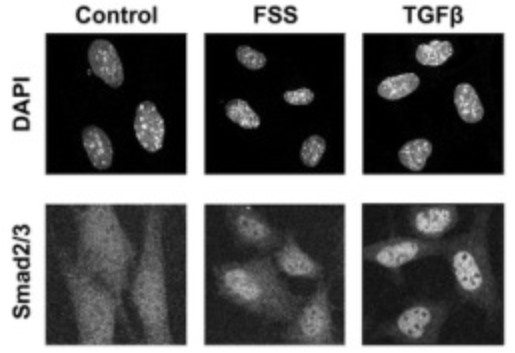
Fig1. Representative images of Smad2/3 nuclear localization in control cells or following 30-minute treatments with FSS (0.1 Pa) or TGFβ (5 ng/mL).
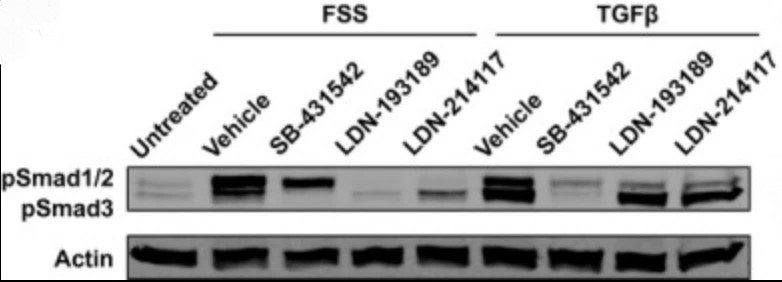
Case study 2: Seong Ji Park, 2016
Transforming growth factor-β1 (TGF-β1) promotes tumor metastasis by inducing an epithelial-to-mesenchymal transition (EMT) in cancer cells. In this study, the researchers investigated the effects of BIX02189 and XMD8-92, pharmacologic inhibitors of the MEK5 [mitogen-activated protein kinase/extracellular-signal-regulated kinase (ERK)5] signaling pathway, on the EMT and migration of cancer cells induced by TGF-β1. In human A549 lung cancer cells, TGF-β1-induced EMT, cell motility, and expression of matrix metalloproteinase-2 were completely inhibited by BIX02189, but not by XMD8-92 or small interference RNAs specific to MEK5 and ERK5. Molecular docking simulation and kinase assays revealed that BIX02189 binds directly to the ATP-binding site of the TGF-β receptor type I (TβRI) and suppresses its kinase activity. Finally, the anti-metastatic effect of BIX02189 was validated in a TβRI-derived A549 xenograft mouse model.
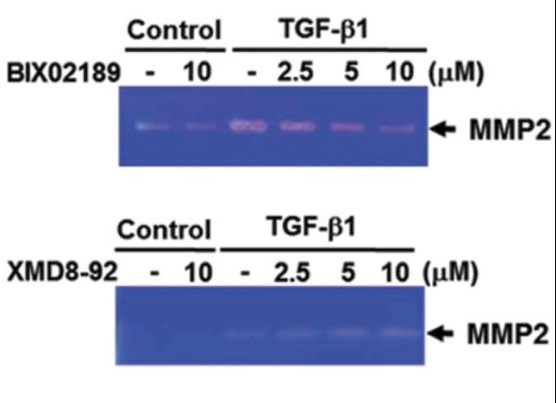
Fig3. A549 cells were pretreated with BIX02189 (upper panel) or XMD8-92 (lower panel) at the indicated concentrations for 30 min and then stimulated with TGF-β1 (5 ng/ml) for 36 h in serum-free medium.
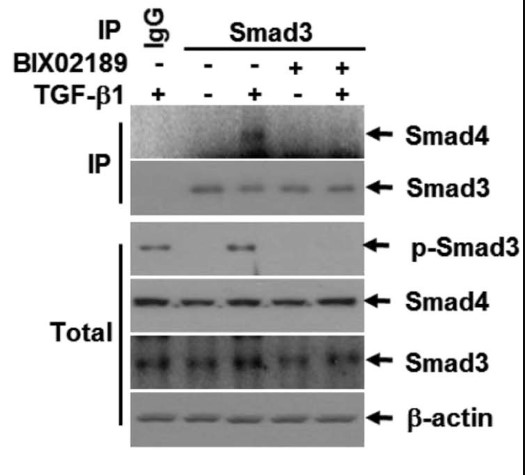
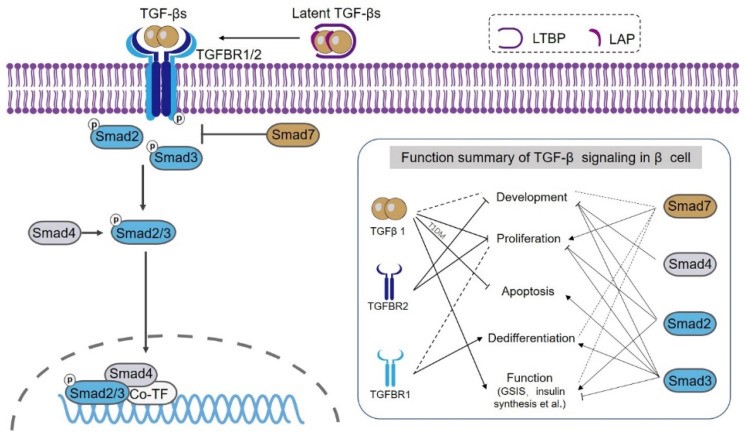
Fig1. G–CSF–PK2-STAT3 signaling circuit in neutrophils. (Hong-Lian Wang, 2022)
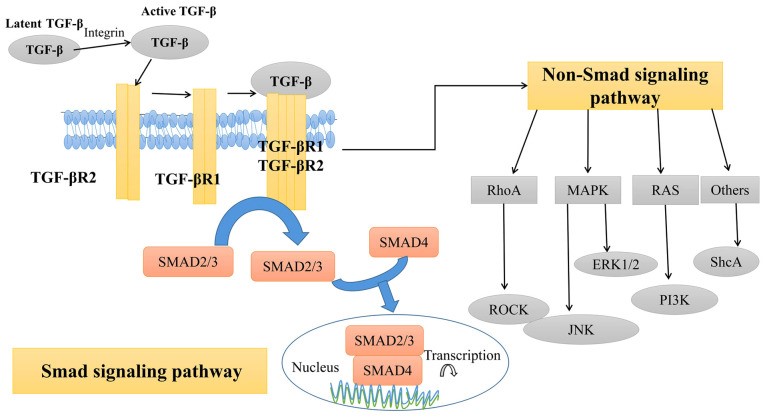
Fig2. TGF-β signaling pathway. In the Smad signaling pathway, the latent TGF-β is activated by integrins and becomes active TGF-β. (Junmin Wang, 2021)
TGFBR1 involved in several pathways and played different roles in them. We selected most pathways TGFBR1 participated on our site, such as MAPK signaling pathway, Cytokine-cytokine receptor interaction, FoxO signaling pathway, which may be useful for your reference. Also, other proteins which involved in the same pathway with TGFBR1 were listed below. Creative BioMart supplied nearly all the proteins listed, you can search them on our site.
| Pathway Name | Pathway Related Protein |
|---|---|
| MAPK signaling pathway | PPM1NA;GNG12;MRAS;DDIT3;C11orf52;MAP3K1;STK4;MAP3K5;PRKACAB |
| Cytokine-cytokine receptor interaction | KITLG;TNFRSF13C;IL3;CCL22;CNTFR;IL2RG;KITA;IL26;LTB |
| FoxO signaling pathway | PIK3CB;MAP2K2B;PRKAB1A;GADD45B;SGK2B;AKT2L;SETD7;GABARAP;EP300 |
| Endocytosis | VPS29;RAB5B;IL2RA;CHMP4B;ADRB1;HLA-G;HLA-B;WASL;CYTH4B |
| TGF-beta signaling pathway | BMP4;SMAD7;RHOAB;BMPR1B;ZFYVE9;RPS6KB1B;NOG;SMAD7B;AMH |
| Osteoclast differentiation | MAPK10;IFNAR1;RELB;PIK3CB;TNFRSF11B;IFNGR1;SYK;LILRA5;SIRPG |
| Hippo signaling pathway | PPP1CB;DVL3;Fzd4;WNT9A;FZD3;LATS2;WNT5B;PPP2R1B;WNT2 |
| Adherens junction | RHOAB;RAC1;CTNNA1;YES1;TCF7;PVRL4;CSNK2A2;WAS;CSNK2A1 |
| Chagas disease (American trypanosomiasis) | IL12B;IRAK4;PIK3R5;GNA14;BDKRB2;GNAO1;TLR6;CFLAR;SMAD2 |
| Hepatitis B | YWHAB;CCNA1;GRB2;TGFB3;STAT4;RELA;NFKB1;HBXIP;MAVS |
| HTLV-I infection | HLA-DOB;CCND1;RRAS;HLA-DRB4;ELK4;POLE;POLE4;WNT7B;PIK3R1 |
| Pathways in cancer | FGF11;MSH2;GNB4;STAT5A;FGF5;RARA;RBX1;PML;PGF |
| Colorectal cancer | TCF7L2;ARAF;SMAD4;GSK3B;TGFBR2;MAPK8;BAD;AKT2;MSH6 |
| Pancreatic cancer | BAD;RALGDS;MAPK1;CASP9;MAPK8;AKT2;MAPK9;STAT3;RAC2 |
| Chronic myeloid leukemia | BCR;GRB2;PIK3R5;STAT5A;IKBKG;TGFBR2;CCND1;HDAC2;MDM2 |
TGFBR1 has several biochemical functions, for example, ATP binding, I-SMAD binding, SMAD binding. Some of the functions are cooperated with other proteins, some of the functions could acted by TGFBR1 itself. We selected most functions TGFBR1 had, and list some proteins which have the same functions with TGFBR1. You can find most of the proteins on our site.
| Function | Related Protein |
|---|---|
| ATP binding | MYH4;KIF2C;HCK;AKT2;TTBK1;ACACA;SIK2A;LACE1;DDX39 |
| I-SMAD binding | SMAD4;AXIN2;TGFB1I1;AXIN1;SMURF1;SMAD1;SMAD7;TGFBR1;SMAD6 |
| SMAD binding | PURA;SKILB;TOB1;TGFBR3;CTNNB1;SKIL;HIPK2;AXIN1;USP15 |
| contributes_to growth factor binding | TGFBR1;ERBB2;IL6ST;ACVR1B |
| metal ion binding | TRPM6;PRKD1;NUBPL;PKM;IKZF3;ZBTB14;MFNG;KLF16;OAS1 |
| protein binding | APOOL;VPS53;NRBF2;ARMCX1;ERGIC1;PVRL2;NATD1;PCMT1;MAGEA3 |
| protein kinase activity | EPHB3A;PIK3CG;BMPR2B;MAP4K3;RPS6KB1B;RLN1;IGF1RB;FYNB;CASKB |
| protein serine/threonine kinase activity | GM711;CHEK2;CLK3;TSSK6;FASTK;PAK2A;CSNK1G2B;MAPK12;LMTK3 |
| receptor signaling protein activity | TYROBP;FCGR1A;RGS12B;PLCE1;RAF1A;TIAM2;FLRT1;SMAD1;DOK5 |
| receptor signaling protein serine/threonine kinase activity | PAK2B;STK25A;ACVR2A;ACVR1BA;TGFBR1;ACVR1B;BMPR1AA;TGFBR2;AMHR2 |
| transforming growth factor beta binding | ITGAV;THBS1;ACVR1;LTBP1;TGFBR2;TGFB3;LTBP4;VASN;TGFBR3 |
| contributes_to transforming growth factor beta binding | TGFBR2;TGFBR3;ENG;TGFBR1 |
| transforming growth factor beta receptor activity, type I | TGFBR1;ACVR1;BMPR1B |
| transforming growth factor beta-activated receptor activity | BMPR2A;TGFBR1;TGFBR3;LTBP1;ACVRL1;ENG;TGFBR2;BMPR2B |
| contributes_to transforming growth factor beta-activated receptor activity | |
| type II transforming growth factor beta receptor binding | TGFBR3;TGFBR1;TGFB1;TGFB3;BAMBI;TGFB2;TGFB1A;ENG |
TGFBR1 has direct interactions with proteins and molecules. Those interactions were detected by several methods such as yeast two hybrid, co-IP, pull-down and so on. We selected proteins and molecules interacted with TGFBR1 here. Most of them are supplied by our site. Hope this information will be useful for your research of TGFBR1.
q99ib8-pro_0000045599; TGFB3; FKBP1A; YWHAZ; TGFB1; Rnf5
- Q&As
- Reviews
Q&As (6)
Ask a questionIn-depth study of the signaling pathways and regulatory mechanisms of TGFBR1 can provide important clues for the development of therapeutic strategies for related diseases.
Gene polymorphisms in TGFBR1 may be associated with susceptibility to some diseases, such as heart disease and diabetes.
Yes, TGFBR1 regulates the proliferation and differentiation of osteocytes in the skeletal system and has been implicated in diseases of the skeletal system.
The TGFBR1 pathway is involved in a variety of pathological processes in liver diseases, such as fibrosis and the occurrence of liver cancer.
Some inhibitors of TGFBR1 have been developed, such as LY2157299 and SD-208.
TGFBR1 may play a role in regulating glomerular injury, fibrosis and renal failure in kidney disease.
Customer Reviews (3)
Write a reviewEasy to purify and high purity in production.
The protein has strong reducibility.
He did well in the ELISA test.
Ask a Question for All TGFBR1 Products
Required fields are marked with *
My Review for All TGFBR1 Products
Required fields are marked with *


